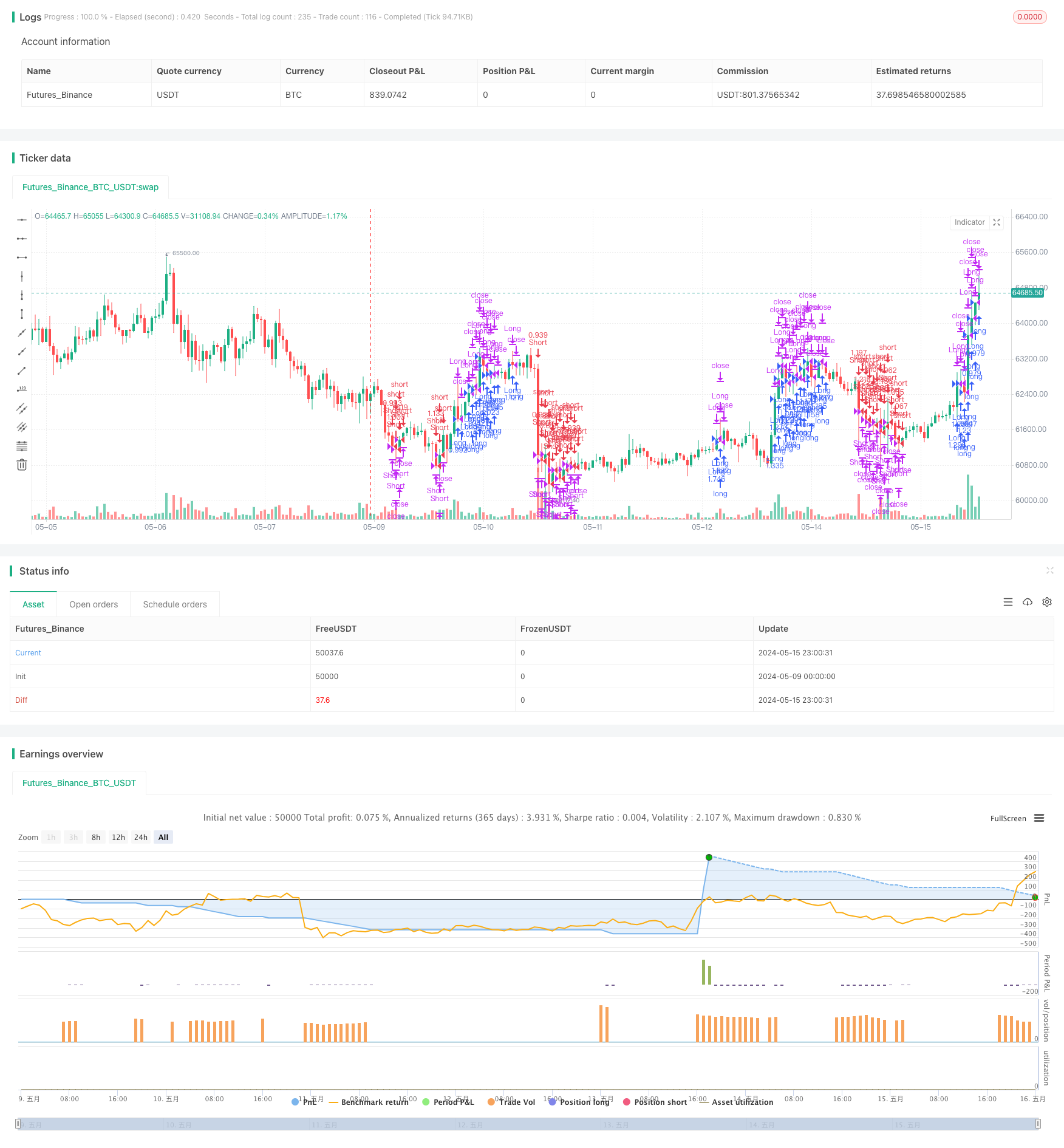
概述
该策略主要利用ATR(Average True Range,平均真实波动范围)和SMA(Simple Moving Average,简单移动平均线)两个指标来判断市场的整理和突破,从而进行交易。策略的主要思路是:当价格突破ATR上下轨时,认为市场发生突破,进行开仓;当价格回到ATR轨道内时,认为市场进入整理,平仓离场。同时,策略还使用了风险控制和仓位管理,以控制每笔交易的风险和仓位大小。
策略原理
- 计算ATR指标和SMA指标,ATR用于判断市场的波动性,SMA用于判断市场的平均价格水平。
- 根据ATR和SMA计算上下轨,上轨为SMA + ATR * multiplier,下轨为SMA - ATR * multiplier,multiplier为用户自定义的倍数。
- 判断市场是否处于整理状态,当最高价低于上轨且最低价高于下轨时,认为市场处于整理状态。
- 判断市场是否发生突破,当最高价突破上轨时,认为发生向上突破;当最低价跌破下轨时,认为发生向下突破。
- 根据突破情况进行开仓,向上突破开多仓,向下突破开空仓。
- 根据止损和止盈条件进行平仓,当价格触及止损价格(SMA - ATR * stop_loss_percentage)或止盈价格(SMA + ATR * take_profit_percentage)时,平仓离场。
- 根据用户自定义的风险比例(risk_percentage)计算每笔交易的风险金额(risk_per_trade),然后根据ATR计算仓位大小(position_size)。
优势分析
- 策略逻辑清晰,易于理解和实现。
- 使用ATR指标判断市场波动性,能够适应不同的市场状况。
- 使用SMA指标判断市场平均价格水平,能够跟踪市场的主要趋势。
- 在开仓时考虑了市场的整理状态,能够避免在震荡市场中频繁交易。
- 使用了止损和止盈,能够有效控制每笔交易的风险。
- 使用了仓位管理,能够根据账户资金和风险比例自动调整仓位大小。
风险分析
- 策略在震荡市场中表现可能不佳,因为频繁的突破和整理可能导致频繁的开仓和平仓,从而增加交易成本。
- 策略的参数设置对策略表现有很大影响,不同的参数可能导致完全不同的结果,因此需要仔细调试和优化参数。
- 策略的止损和止盈设置可能不够灵活,固定的百分比止损和止盈可能无法适应不同的市场状况。
- 策略的仓位管理可能过于简单,没有考虑市场趋势和波动性等因素,可能导致在某些情况下仓位过大或过小。
优化方向
- 可以考虑添加趋势过滤条件,例如只在趋势向上时开多仓,在趋势向下时开空仓,以避免在震荡市场中频繁交易。
- 可以考虑使用更加灵活的止损和止盈方式,例如根据ATR或者市场波动性动态调整止损和止盈距离,以适应不同的市场状况。
- 可以考虑使用更加复杂的仓位管理方法,例如根据市场趋势和波动性调整仓位大小,以控制风险和提高收益。
- 可以考虑添加其他过滤条件,例如交易量、波动率等,以进一步提高策略的可靠性和稳定性。
总结
该策略使用ATR和SMA两个简单的指标,通过判断价格突破和整理来进行交易,同时使用了风险控制和仓位管理来控制每笔交易的风险和仓位大小。策略逻辑清晰,易于理解和实现,但是在实际应用中可能存在一些问题,例如在震荡市场中表现不佳,参数设置对策略表现影响很大,止损和止盈设置不够灵活,仓位管理过于简单等。因此,在实际应用中需要根据具体情况进行优化和改进,例如添加趋势过滤条件,使用更加灵活的止损和止盈方式,使用更加复杂的仓位管理方法,添加其他过滤条件等,以提高策略的可靠性和稳定性。
策略源码
/*backtest
start: 2024-05-09 00:00:00
end: 2024-05-16 00:00:00
period: 1h
basePeriod: 15m
exchanges: [{"eid":"Futures_Binance","currency":"BTC_USDT"}]
*/
//@version=5
strategy("Consolidation Breakout Strategy", overlay=true)
// Input Parameters
length = input.int(20, "Length", minval=1)
multiplier = input.float(2.0, "Multiplier", minval=0.1, maxval=10.0)
risk_percentage = input.float(1.0, "Risk Percentage", minval=0.1, maxval=10.0)
stop_loss_percentage = input.float(1.0, "Stop Loss Percentage", minval=0.1, maxval=10.0)
take_profit_percentage = input.float(2.0, "Take Profit Percentage", minval=0.1, maxval=10.0)
// ATR calculation
atr_value = ta.atr(length)
// Average price calculation
average_price = ta.sma(close, length)
// Upper and lower bounds for consolidation detection
upper_bound = average_price + multiplier * atr_value
lower_bound = average_price - multiplier * atr_value
// Consolidation detection
is_consolidating = (high < upper_bound) and (low > lower_bound)
// Breakout detection
is_breakout_up = high > upper_bound
is_breakout_down = low < lower_bound
// Entry conditions
enter_long = is_breakout_up and not is_consolidating
enter_short = is_breakout_down and not is_consolidating
// Exit conditions
exit_long = low < (average_price - atr_value * stop_loss_percentage) or high > (average_price + atr_value * take_profit_percentage)
exit_short = high > (average_price + atr_value * stop_loss_percentage) or low < (average_price - atr_value * take_profit_percentage)
// Risk calculation
risk_per_trade = strategy.equity * (risk_percentage / 100)
position_size = risk_per_trade / atr_value
// Strategy
if (enter_long)
strategy.entry("Long", strategy.long, qty=position_size)
if (enter_short)
strategy.entry("Short", strategy.short, qty=position_size)
if (exit_long)
strategy.close("Long")
if (exit_short)
strategy.close("Short")
相关推荐